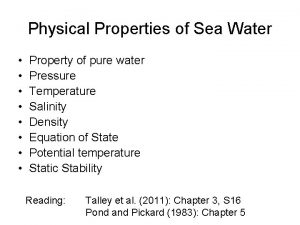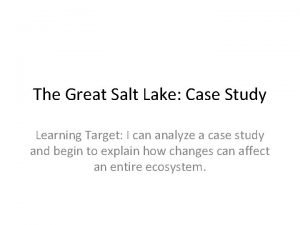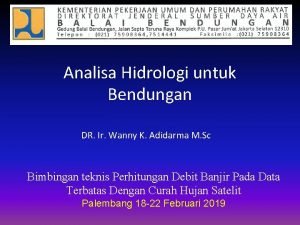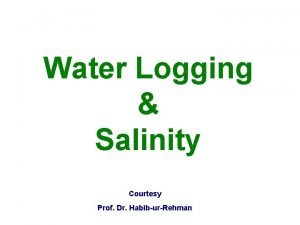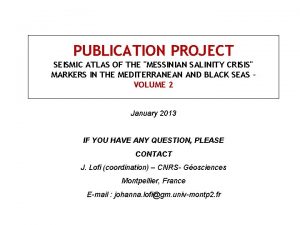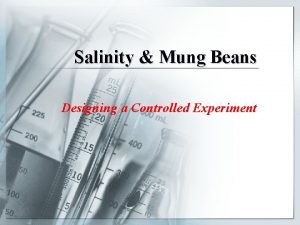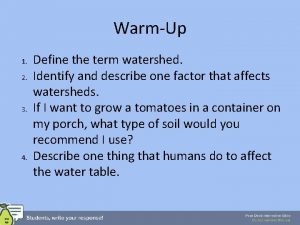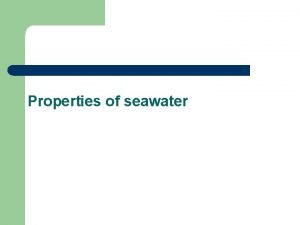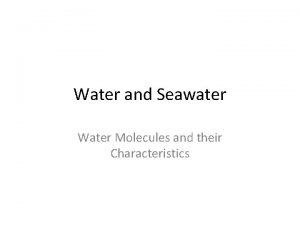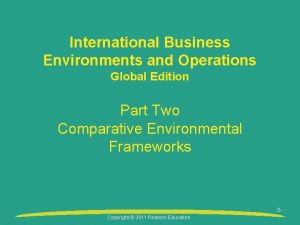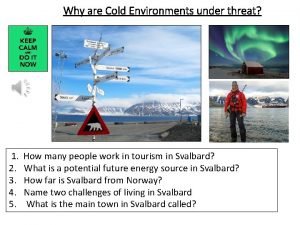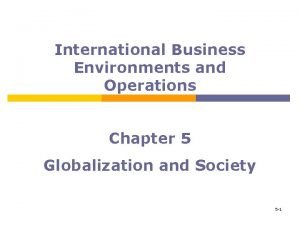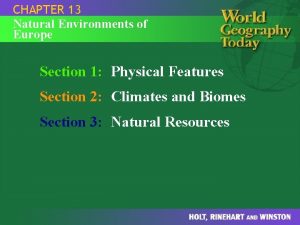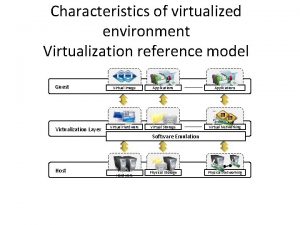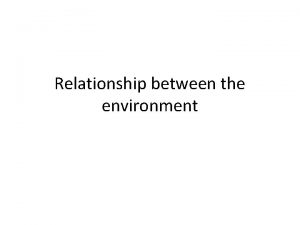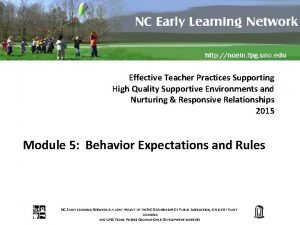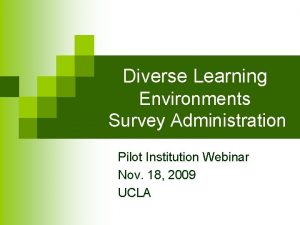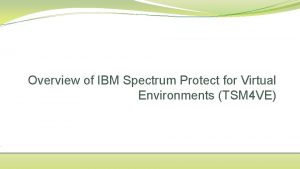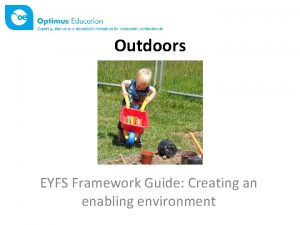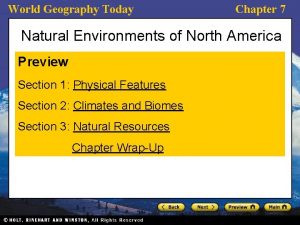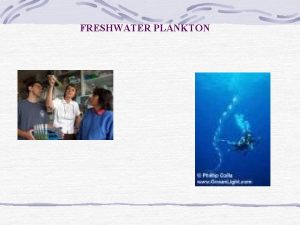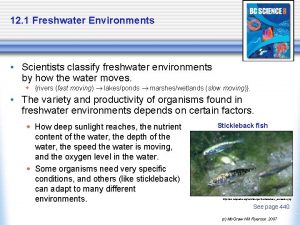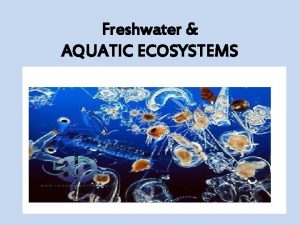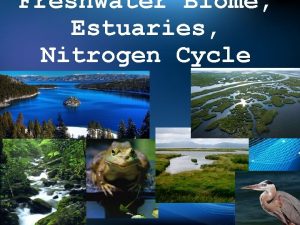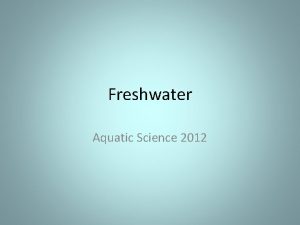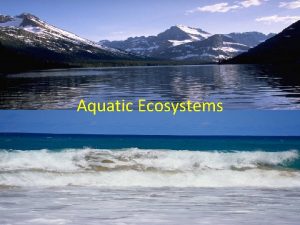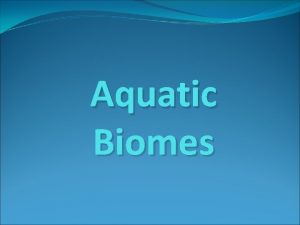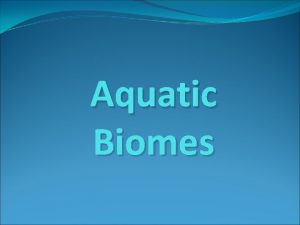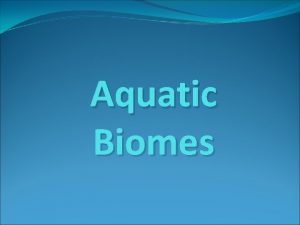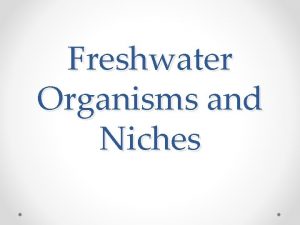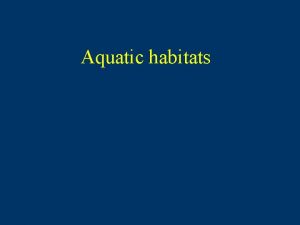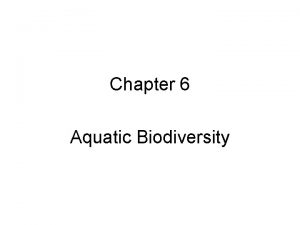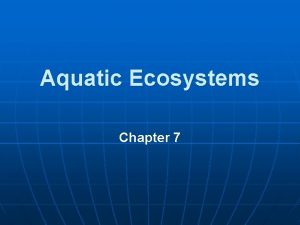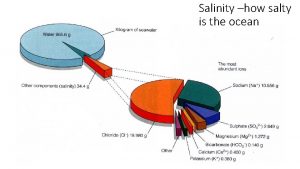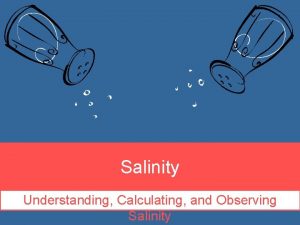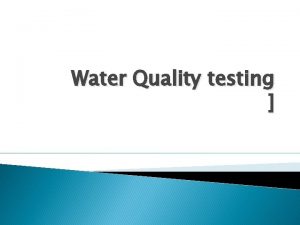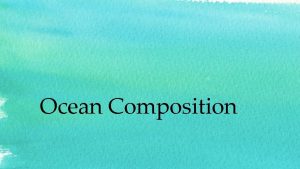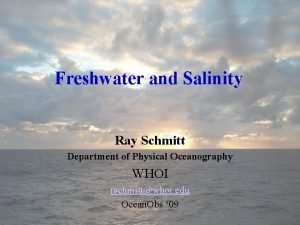AQUATIC ENVIRONMENTS SaltwaterMarine or Freshwater Depends on salinity































- Slides: 31

AQUATIC ENVIRONMENTS Saltwater/Marine or Freshwater? Depends on “salinity”. Figure 6 -3

4 Types of Aquatic Organisms • Classified by size, movement, and niche.

1. Plankton • Weakly swimming or freefloating. Indicators of environmental change – Phytoplankton - algae – Zooplankton – protozoa to jellyfish – Ultraplankton – photosynthetic bacteria – super oxygenators

2. Nekton • Larger, strong-swimming consumers. – Ex: Fish, turtles, whales, etc

3. Benthos • Bottom dwelling – nonswimming – consumers or detritivores. – Ex: Worms, barnacles, oysters/clams, and lobsters/crawfish.

4. Decomposers • Break down organic compounds • mostly bacteria

Layers of Aquatic Life • Factors in determining organism’s niche – Light – Temperature – DO – Nutrients • Euphotic Zone – upper • Bathyal Zone - middle • Aphotic or Abyssal Zone - lower • Mixing/Upwelling can create an oasis

Open Sea level Twilight Euphotic Zone Estuarine Zone Continental shelf Bathyal Zone The Coastal Zone • Warm, nutrient-rich, shallow water extending from the high-tide mark on land to the shallow edge of the continental shelf. • Makes up less than 10% of the world’s ocean area but contains 90% of all marine species. • Provides numerous ecological and economic services ex. Fishing, fuel, building materials. Photosynthesis Sun Abyssal Zone Darkness High tide Coastal Zone Low tide Fig. 6 -5, p. 130

• Scientists estimate that marine systems provide $21 trillion in goods and services per year – 70% more than terrestrial ecosystems. Figure 6 -4

Sandy Beach Tidal Zone Life Beach flea Peanut worm Blue crab Tiger Beetle Clam Dwarf Olive High tide Sandpiper Low tide White sand macoma Sand dollar Mole Shrimp Ghost Shrimp Moon snail Fig. 6 -9, p. 132

Barrier Islands – ex. South Padre • Low, narrow, offshore sandy islands • Dunes protect land from sea wave erosion during tide changes.


Rocky Intertidal • Intense wave action on rocks • Submerged at high tide & exposed at low tide • Anchored to rock: Barnacles, sponges, mussels

Continue poster research • Add coastal information (barrier islands, native organisms, etc) • Make your poster an advertisement for the aquatic in your state (fresh/marine) • Poster due 10/22

Your coastal state aquatic zone • Research a river and lake and wetland estuary and coastal zone in your coastal state. Research: • - ecological importance • -economic importance • -river headwater vs downstream comm. • -lake life, turnover • Human impact on aquatic zone • Marine organisms/habitat • Add coastal information (barrier islands, native organisms, estuary, etc) • Make your poster an advertisement for the aquatic in your state (fresh/marine) • Poster due 10/22

Kelp forest • Underwater giant algae (150 ft) in productive ecosystem

Trophic cascade – keystone species

Coral Reefs • Warm shallow nutrientpoor waters • Corals – tiny animals secrete Ca. CO 3 to form exoskeleton & Algae live in body tissues (mutualism) • Habitat, Huge colonies - Amazingly diverse ecosystem Figure 6 -11

Indicator of climate change • Coral bleaching when algae dies b/c disease, lower p. H (ocean acidification due to increasing CO 2), higher water temperatures • Ocean pollutants, sunscreen

Ocean Acidification • As carbon dioxide (CO 2) is absorbed from the atmosphere it bonds with sea water forming carbonic acid. This acid then releases a bicarbonate ion and a hydrogen ion. The hydrogen ion bonds with free carbonate ions in the water forming another bicarbonate ion. • That carbonate would otherwise be available to marine animals for making calcium carbonate shells and skeletons. So the more dissolved carbon dioxide in the ocean, the less free carbonate ions available for making calcium carbonate.

Estuaries and Coastal Wetlands • Partially enclosed area of coastal water where sea water mixes with freshwater. Figure 6 -7

Estuary Productivity • Filter excess nutrients and pollutants. • Reduce storm damage by absorbing waves, storm surges & storing excess water. • Provide food, habitats, and nursery sites for many aquatic species.

Salt marsh • Low, wet muddy • Salt-tolerant grass and low growing plants • Nursery for fish, shrimp, crabs, birds Herring gulls Peregrine falcon Snowy Egret Cordgrass Short-billed Dowitcher Marsh Periwinkle Phytoplankton Smelt Soft-shelled clam Zooplankton and small crustaceans Clamworm Bacteria Producer to primary consumer Primary to secondary consumer Secondary to higher-level consumer All consumers and producers to decomposers

Mangrove forest/swamp • Found along sandy and silty tropical coastlines • Mangroves: salttolerant trees • Nursery for fish, shrimp, crabs, birds

Mudflat • Tides or rivers deposit lots of sediments • Underwater most of time • Tube worms, mud snails, clams, oysters, crabs • Birds & other animals visit for feeding

Open Sea level Euphotic Zone Photosynthesis Estuarine Zone Continental shelf Sun Twilight High tide Coastal Zone Low tide Bathyal Zone • Life zones based on light. • Productivity is low in the open ocean. • Life becomes more abundant toward the poles due to presence of producers. Abyssal Zone Darkness The Open Sea Fig. 6 -5, p. 130

Biological Zones in the Open Sea: Light Rules • Euphotic zone: brightly lit surface layer. (photic zone) – Nutrient levels low, dissolved O 2 high, photosynthetic activity. • Bathyal zone: dimly lit middle layer. – No photosynthetic activity, zooplankton and fish live there and migrate to euphotic zone to feed at night. • Abyssal zone: dark bottom layer. (aphotic zone) – Very cold, little dissolved O 2.

Open Ocean - pelagic • From edge of continental shelf outward • Largest marine ecosystem (fish, mammals, plankton) • Global ocean currents

Benthic Zone/Sea Floor • along ocean floor • organisms depend on detritus from upper zones • Sparse populations • Sea stars, anemones, worms, clams, sea cucumbers

Hydrothermal Vent • Very deep, concentrated along mid-atlantic ridge • Extremely hot, mineral rich water, no light; productivity from chemosynthetic bacteria • Tubeworms, eyeless shrimp, crabs, Archaebacteria

Continue poster research • Add coastal information (barrier islands, native organisms, etc) • Kelp? Coral reef? Estuary? • Make your poster an advertisement for the aquatic life in your state (fresh/marine) • Poster due 10/22
 Physical properties of seawater
Physical properties of seawater Specific volume units
Specific volume units Salinity of great salt lake
Salinity of great salt lake Dryland salinity
Dryland salinity Water logging and salinity
Water logging and salinity Messinian salinity crisis
Messinian salinity crisis Mung bean salinity experiment
Mung bean salinity experiment Salinity
Salinity Salinity unit of measurement
Salinity unit of measurement Salinity vertical profile
Salinity vertical profile Dead sea salinity ppt
Dead sea salinity ppt International business environments and operations
International business environments and operations Why are cold environments under threat
Why are cold environments under threat Creating supportive environments smoking
Creating supportive environments smoking International business chapter 5
International business chapter 5 Implations
Implations Chapter 13 natural environments of europe
Chapter 13 natural environments of europe Peng cui tsinghua
Peng cui tsinghua Characteristics of virtualized environments
Characteristics of virtualized environments Exercise in hot and cold environments
Exercise in hot and cold environments Micro market and macro environment
Micro market and macro environment High quality supportive environments
High quality supportive environments Diverse learning environments survey
Diverse learning environments survey Jonassen constructivism
Jonassen constructivism Psychologically informed environments
Psychologically informed environments Business environment definition
Business environment definition International business environments and operations
International business environments and operations Different environments
Different environments Dsmcsvc
Dsmcsvc Internal and external environment of the school system
Internal and external environment of the school system Enabling environments eyfs
Enabling environments eyfs Chapter 7 natural environments of north america
Chapter 7 natural environments of north america
